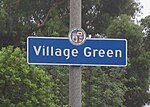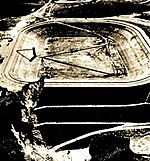Baldwin Hills, Los Angeles
Baldwin Hills, Los AngelesBaldwin Hills (mountain range)Crenshaw, Los AngelesNeighborhoods in Los AngelesOlympic Villages ... and 2 more
South Los AngelesVenues of the 1932 Summer Olympics

Baldwin Hills is a neighborhood within the South Los Angeles region of Los Angeles, California. It is often referred to as the Black Beverly Hills. It is home to Kenneth Hahn State Regional Park and to Village Green, a National Historic Landmark.
Excerpt from the Wikipedia article Baldwin Hills, Los Angeles (License: CC BY-SA 3.0, Authors, Images).Baldwin Hills, Los Angeles
Veronica Street, Los Angeles
Geographical coordinates (GPS) Address Nearby Places Show on map
Geographical coordinates (GPS)
| Latitude | Longitude |
|---|---|
| N 34.013 ° | E -118.357 ° |
Address
Veronica Street 5132
90008 Los Angeles
California, United States
Open on Google Maps









